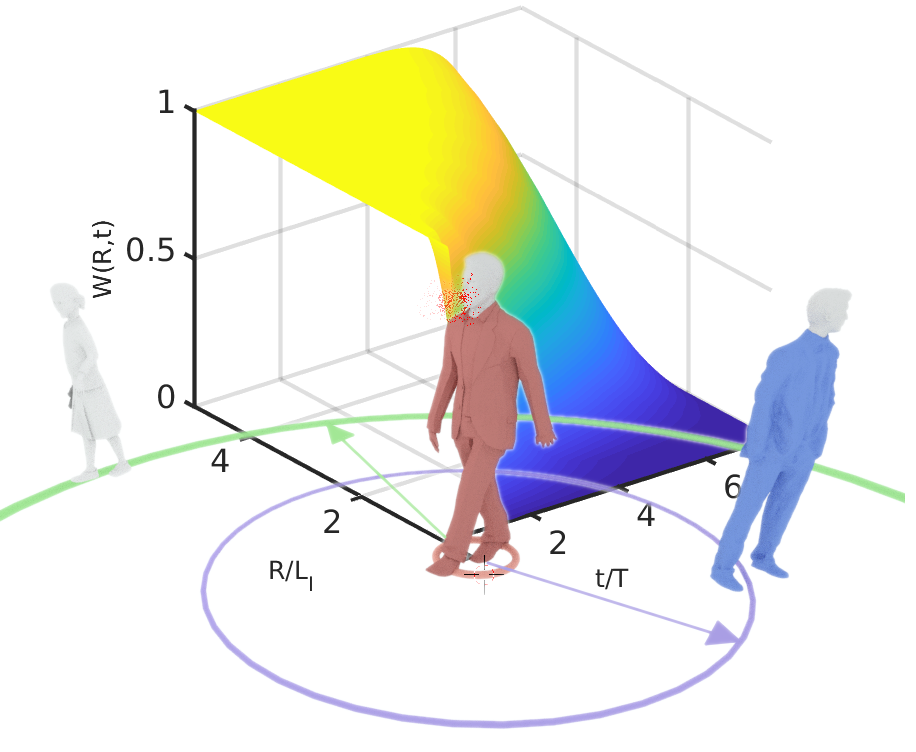Quantifying the spread of virus-bearing aerosols by atmospheric turbulent flows
Physical distancing plays an important role in arresting the spread of SARS-CoV-2, which has caused the COVID-19 pandemic. To optimise such physical distancing, we must ask: How far, and how fast, do small respiratory droplets or virus-bearing aerosols spread in turbulent flows? An infected person, breathing or speaking loudly, emits fine droplets (virus-bearing aerosols), which remain suspended in the atmosphere for a long time and are then spread by the turbulent air flow, in much the same way as a perfume is dispersed (the underlying mathematical equations are the same).
 By using computer simulations and theory, researchers from the Department of Physics and their collaborators quantify how long it takes for such fine droplets to reach a certain distance from their source for the first time via turbulent advection. Turbulence is scale invariant at intermediate length scales, from the large integral length scale to the small dissipation length scale; the researchers show that this integral scale plays a crucial role here. They demonstrate that aerosol particles reach distances much smaller than this integral scale very rapidly, for they move ballistically. For distances larger than or comparable to the integral scale, the aerosol particles diffuse; hence, they propagate slowly. Indoors, say in an office, the integral scale is roughly the distance between people or the size of a cubicle, whichever is smaller. For example, if we consider two persons separated by a distance of 3m, in a typical office with an integral scale comparable to 2m, we show that, in about a minute, it is almost certain that an aerosol particle, emitted by one person, has reached the other.
By using computer simulations and theory, researchers from the Department of Physics and their collaborators quantify how long it takes for such fine droplets to reach a certain distance from their source for the first time via turbulent advection. Turbulence is scale invariant at intermediate length scales, from the large integral length scale to the small dissipation length scale; the researchers show that this integral scale plays a crucial role here. They demonstrate that aerosol particles reach distances much smaller than this integral scale very rapidly, for they move ballistically. For distances larger than or comparable to the integral scale, the aerosol particles diffuse; hence, they propagate slowly. Indoors, say in an office, the integral scale is roughly the distance between people or the size of a cubicle, whichever is smaller. For example, if we consider two persons separated by a distance of 3m, in a typical office with an integral scale comparable to 2m, we show that, in about a minute, it is almost certain that an aerosol particle, emitted by one person, has reached the other.
REFERENCE:
A.K. Verma, A. Bhatnagar, D. Mitra, and R. Pandit, First-passage-time problem for tracers in turbulentflows applied to virus spreading, Physical Review Research2 (3), 033239 (2020).
LAB WEBSITE: http://www.physics.iisc.ac.in/~rahul/




 By using computer simulations and theory, researchers from the Department of Physics and their collaborators quantify how long it takes for such fine droplets to reach a certain distance from their source for the first time via turbulent advection. Turbulence is scale invariant at intermediate length scales, from the large integral length scale to the small dissipation length scale; the researchers show that this integral scale plays a crucial role here. They demonstrate that aerosol particles reach distances much smaller than this integral scale very rapidly, for they move ballistically. For distances larger than or comparable to the integral scale, the aerosol particles diffuse; hence, they propagate slowly. Indoors, say in an office, the integral scale is roughly the distance between people or the size of a cubicle, whichever is smaller. For example, if we consider two persons separated by a distance of 3m, in a typical office with an integral scale comparable to 2m, we show that, in about a minute, it is almost certain that an aerosol particle, emitted by one person, has reached the other.
By using computer simulations and theory, researchers from the Department of Physics and their collaborators quantify how long it takes for such fine droplets to reach a certain distance from their source for the first time via turbulent advection. Turbulence is scale invariant at intermediate length scales, from the large integral length scale to the small dissipation length scale; the researchers show that this integral scale plays a crucial role here. They demonstrate that aerosol particles reach distances much smaller than this integral scale very rapidly, for they move ballistically. For distances larger than or comparable to the integral scale, the aerosol particles diffuse; hence, they propagate slowly. Indoors, say in an office, the integral scale is roughly the distance between people or the size of a cubicle, whichever is smaller. For example, if we consider two persons separated by a distance of 3m, in a typical office with an integral scale comparable to 2m, we show that, in about a minute, it is almost certain that an aerosol particle, emitted by one person, has reached the other.